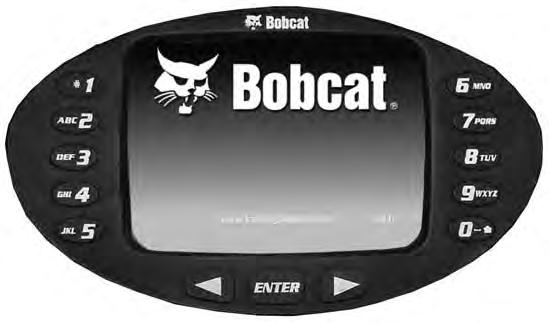
25 minute read
INSTRUMENTS AND CONSOLES (CONT’D)
Instrument Panel - Deluxe Figure
P-97991 1 3
This machine may be equipped with a Deluxe Instrument Panel [Figure 13].
1. Keypad (1 through 0): The keypad has two functions:
- To enter a number code (password) to allow starting the engine.
- To enter a number as directed for further use of the display screen.
2. Display Screen: The display screen is where all system setup, monitoring, and error conditions are displayed.
3. Scroll Buttons: Used to scroll through display screen choices.
4. ENTER Button: Used to make selections on the display screen.
Turn the start key to the ON position.
P113014
When this screen is on the display you can enter the password and start the engine [Figure 14].
NOTE:Your excavator (with Deluxe Instrument Panel) will have an Owner Password. Your dealer will provide you with this password. Change the password to one that you will easily remember to prevent unauthorised use of your excavator. (See Changing The Owner Password on Page 204.) Keep your password in a safe location for future needs.
Enter The Password:
Use the numbers on the keypad to enter the password, then press the [ENTER] button. A symbol will appear on the display screen for each number entered. The left scroll button can be used to backspace if an incorrect number is entered.
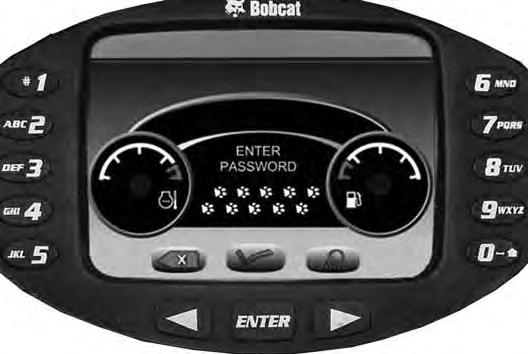
If the correct password is not entered, [INVALID PASSWORD] will appear on the display screen and the password will have to be reentered.
See CONTROL PANEL SETUP for further description of screens to set up the system for your use. (See CONTROL PANEL SETUP on Page 197.)
Lights
Press key pad [1] [Figure 14] once for FRONT work lights. Press a second time to turn all lights off.
Change Language:
INSTRUMENTS AND CONTROLS (CONT’D)


Radio Option
15
NOTE:See DISPLAY (Item 3) in the following table for clock setting instructions.
INSTRUMENT AND CONTROLS (CONT’D)
Radio (Cont’d)
REF. NO. DESCRIPTION
FUNCTION / OPERATION
1POWERPress to turn ON; press again to turn OFF.
2MUTEPress to mute audio output; [MUTE] will appear in display screen; press again to turn OFF.
3DISPLAYPress to toggle between function mode (showing tuner frequency, auxiliary input, weather band information, or timer) and clock mode.
Press and hold to enter clock setting mode; use FREQUENCY DOWN (TUN -) button to adjust hours and FREQUENCY UP (TUN +) button to adjust minutes; normal operation will resume automatically.
4BANDPress to select tuner mode. Press to cycle through 2 AM (MW) bands and 3 FM bands.
5AUXILIARYPress to select Auxiliary Input mode. Portable audio device (MP3 player) must be attached to auxiliary input jack.
6WEATHER BANDPress to select weather band; use FREQUENCY UP (TUN +) and FREQUENCY DOWN (TUN -) buttons to adjust to the clearest station. The weather alert feature, if activated, will automatically switch from the current function to the weather band if a weather warning is received. See AUDIO / MENU ADJUSTMENT in this table.
7TIMER Press to access timer mode. Press to start the timer function; press again to stop timer; press again to resume timer or press and hold to reset timer and exit from timer mode.
8DISPLAY SCREENDisplays the time, frequency, and activated functions.
9VOLUME UPAdjusts volume up; current volume (0 - 40) will appear briefly in display screen.
10AUDIO / MENU ADJUSTMENT AUDIO ADJUSTMENT: Press to cycle through bass, treble, and balance settings; use VOLUME UP (VOL +) and VOLUME DOWN (VOL -) buttons to adjust when desired option is displayed; normal operation will resume automatically.
MENU ADJUSTMENT: Press and hold for 3 seconds to enter menu adjustment settings; press to cycle through the following settings; use VOLUME UP (VOL +) and VOLUME DOWN (VOL -) buttons to adjust when desired option is displayed; normal operation will resume automatically.
• Beep Confirm (On or Off) - Determines if beep will sound with each button press.
• Operation Region (USA or Europe) - Selects the appropriate region.
• Clock Display (12 or 24) - Selects a 12-hour or 24-hour clock display.
• Display Brightness (Low, Medium, or High) - Determines brightness level of display screen.
• Backlight Colour (Amber or Green) - Determines backlight colour of display screen.
• Power On Volume (0 - 40) - Selects default volume setting when radio is turned on.
• WB Alert (On or Off) - Determines if weather band alert feature is activated.
11FREQUENCY DOWNPress to manually tune the radio frequency down.
12FREQUENCY UPPress to manually tune the radio frequency up.
13VOLUME DOWNAdjusts volume down; current volume (0 - 40) will appear briefly in display screen.
14SEEK FREQUENCY DOWN
15SEEK FREQUENCY UP
Press to automatically tune frequency down to next strong station.
Press to automatically tune frequency up to next strong station.
16PRESET STATIONSUsed to store and recall stations for each AM and FM band. Press and hold to store current station; press button to recall station.
17AUXILIARY INPUT JACK
Connect line output of portable audio device (MP3 player) to 3,5 mm (1/8 in) jack and press AUXILIARY button.
INSTRUMENT AND CONTROLS (CONT’D)

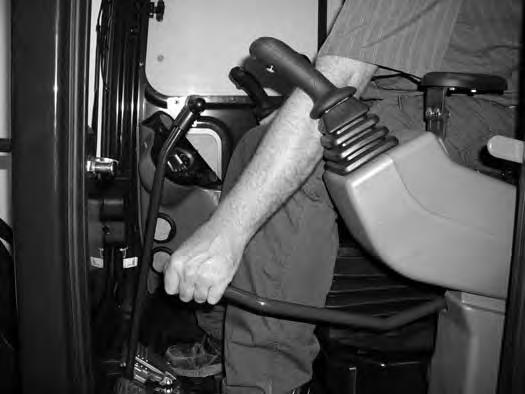
Raising And Lowering The Console
Raise the console before exiting the cab.
Two-Speed Travel
Pull up on the release handle [Figure 17]. The lift spring will assist in raising the console.
Lower the console before operating the excavator.
Push down on the lever [Figure 17] until the latch is engaged.
NOTE:When the console is raised, the hydraulic and traction system functions are locked and will not operate.
If the engine stops, the boom / bucket (attachments) can be lowered to the ground using hydraulic pressure in the accumulator.
The control console must be in the locked down position, and the key switch in the ON position.

When High Range is engaged, the two-speed travel icon (Item 1) [Figure 19] will illuminate.
Press the button (Item 1) [Figure 18] again to disengage.
Auto-Shift Drive System
When in high range, the travel motors will automatically shift to low range when more torque is required and return to high range when hydraulic pressure decreases.
NOTE:Always set the travel speed to low range when loading or unloading the excavator onto a transport vehicle.
INSTRUMENTS AND CONSOLES (CONT’D)
The auto idle feature (when engaged) will reduce the engine speed to low idle when the control levers (joystick, blade, travel, etc.) are in NEUTRAL and not used for approximately four seconds. The engine rpm will return to the set position as soon as any control lever is activated.


The automatic idle switch (Item 1) [Figure 20] is used to engage or disengage the automatic idle feature.
Press the switch (Item 1) once to engage automatic idle and the LED (Item 2) will illuminate. Press the switch (Item 1) a second time to disengage automatic idle, the LED (Item 2) [Figure 20] will be OFF.
NOTE:Always disengage the auto idle feature when loading or unloading the excavator onto a transport vehicle.
Press [ENTER] (Item 1) once to engage automatic idle. Press [ENTER] (Item 1) [Figure 21] again and auto idle will be OFF.
NOTE:Always disengage the auto idle feature when loading or unloading the excavator onto a transport vehicle.
NOTE:When equipped with the deluxe instrument panel, the time delay for auto idle to activate can be adjusted. (See Auto Idle Time Delay on Page 199.)
OPERATOR CANOPY (ROPS / TOPS)
Description
The Bobcat excavator has an operator canopy (ROPS / TOPS) as standard equipment to protect the operator if the excavator is tipped over. The seat belt must be worn for ROPS / TOPS protection.
Check the ROPS / TOPS canopy, mounting, and hardware for damage. Never modify the ROPS / TOPS canopy. Replace the canopy and hardware if damaged. See your Bobcat dealer for parts.
ROPS / TOPS - Roll-Over Protective Structure per ISO 12117-2, and Tip-Over Protective Structure per ISO 12117.
Warning
Never modify operator cab by welding, grinding, drilling holes or adding attachments unless instructed to do so by Bobcat Company. Changes to the cab can cause loss of operator protection from rollover and falling objects, and result in injury or death.
W-2069-0200
OPERATOR CAB (ROPS / TOPS)
Description
The Bobcat excavator has an optional operator cab (ROPS / TOPS) as standard equipment to protect the operator if the excavator is tipped over. The seat belt must be worn for ROPS / TOPS protection.
Check the ROPS / TOPS cab, mounting, and hardware for damage. Never modify the ROPS / TOPS cab. Replace the cab and hardware if damaged. See your Bobcat dealer for parts.
ROPS / TOPS - Roll-Over Protective Structure per ISO 12117-2, and Tip-Over Protective Structure per ISO 12117.
Warning
Never modify operator cab by welding, grinding, drilling holes or adding attachments unless instructed to do so by Bobcat Company. Changes to the cab can cause loss of operator protection from rollover and falling objects, and result in injury or death.
W-2069-0200
OPERATOR CAB (ROPS / TOPS) (CONT’D)
Cab Door
22
The cab door can be locked (Item 1) [Figure 22] with the same key as the starter switch.
When the door is in the open position, push down on the latch (Item 1) [Figure 24] and close the door.
Push the door all the way open until the latch post (Item 1) engages in the latch (Item 2) [Figure 23] to hold the door in the open position.
From inside the cab, open the door using handle (Item 1) [Figure 25]

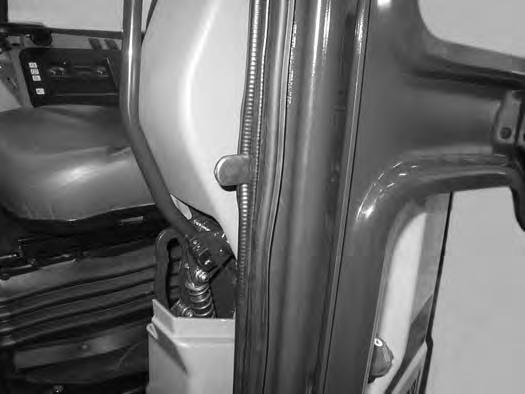

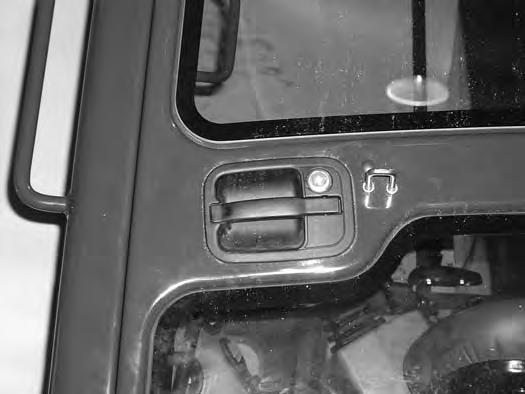
OPERATOR CAB (ROPS / TOPS) (CONT’D)
Front Window
Opening The Front Window
26
Press the window latch button (Item 1) [Figure 26] (both sides).
When the window is fully raised, the latch (Item 1) [Figure 28] (both sides) will close on the bracket in the latched position.
Pull down and forward slightly on the window to make sure it is fully latched.

Closing The Front Window
Use both window grab handles to support the window while pressing the window latch button (Item 2) [Figure 28] (both sides).
Use both window grab handles (Item 1) [Figure 27] to pull the window down fully.
Press the top of the window in until the latch locks into the latched position (both sides) [Figure 26].
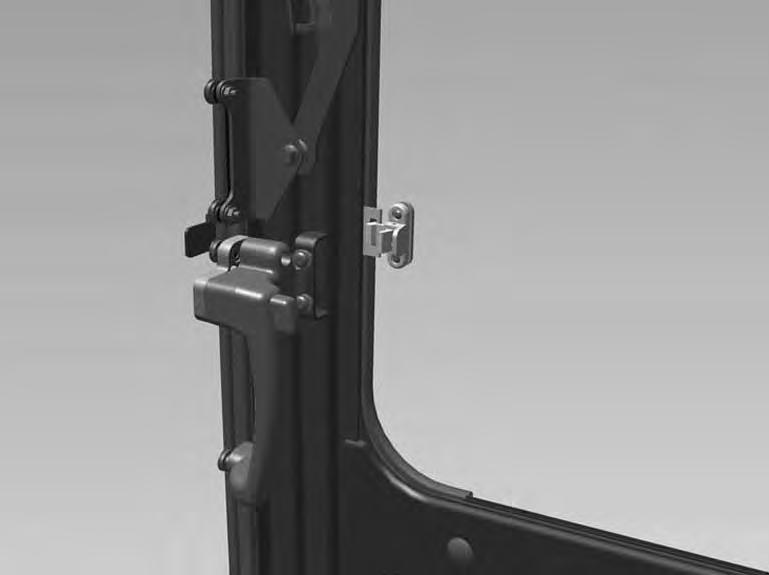
Pull inward and upward slightly on the window to make sure it is fully latched in the closed position.
Use both window grab handles (Item 1) [Figure 27] to pull the top of the window in.
Continue moving the window in and up over the operator’s head until the window is fully raised.

OPERATOR CAB (ROPS / TOPS) (CONT’D)
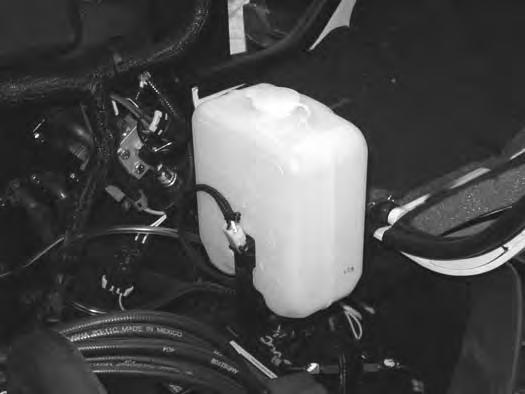
Front Wiper

OPERATOR CAB (ROPS / TOPS) (CONT’D)
Right Side Windows
Opening The Right Rear Window

Figure 31
Raise the latch (Item 1) [Figure 31] located at the rear of the front window.
Figure 32
Pull out on the latch (Item 1) [Figure 32].

Figure 33
Pull the latch (Item 1) [Figure 33] forward to open the window. When the window is in the open position, push down on the latch (Item 1) [Figure 31]
Closing The Right Rear Window
Raise the latch (Item 1) [Figure 31]
Push the latch (Item 1) [Figure 33] back to close the window. Rotate the latch (Item 1) [Figure 31] down.

Opening The Right Front Window
Figure 34
Raise the latch (Item 1) [Figure 34] located at the rear of the front window.
Figure 35
Pull back on the latch (Item 1) [Figure 35]
Figure 36
Pull the latch (Item 1) [Figure 36] back to open the window.
When the window is in the open position, push down on the latch (Item 1) [Figure 34]



Closing The Right Front Window
Raise the latch (Item 1) [Figure 34].
Push the handle (Item 1) [Figure 36] forward to close the window. Rotate the latch (Item 1) [Figure 34] down.
OPERATOR CAB (ROPS / TOPS) (CONT’D)

Heating, Ventilation, And Air Conditioning Ducting
Figure 37
Emergency Exit
The door, the right side rear window and the front window provide exits.
Right Side Rear Window
Figure 38
Front Window
Figure 39
Exit through the window [Figure 38]
Open the front window and exit [Figure 39]
NOTE:If the excavator has a Special Applications Kit installed, the front window is NOT an emergency exit.


This excavator may be equipped with a motion alarm system. The motion alarm (Item 1) [Figure 40] is located inside the rear of the excavator.
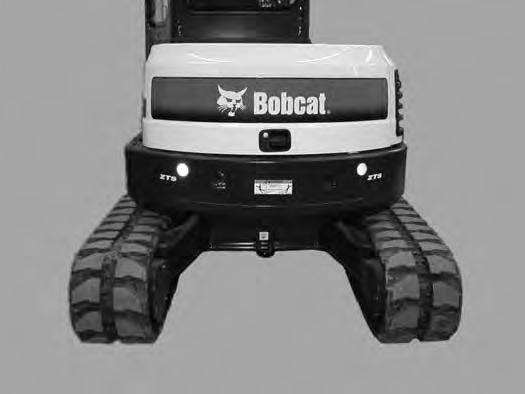
This machine is equipped with a motion alarm. ALARM MUST SOUND! when operating forward or backward.
Failure to maintain a clear view in the direction of travel could result in serious injury or death.
The operator is responsible for the safe operation of this machine.
The motion alarm will sound when the operator moves the travel control levers (Item 1) [Figure 42] in either the forward or reverse direction.

If alarm does not sound or for adjustment instructions, see inspection and maintenance instructions for the motion alarm system in the preventive maintenance section of this manual. (See MOTION ALARM SYSTEM on Page 149.)
The motion alarm can be temporarily disabled by pressing the motion alarm switch (Item 1) [Figure 41] while the machine is moving. As soon as the travel levers are returned to the NEUTRAL position, the motion alarm will be enabled.
Travel Controls
Forward And Reverse Travel
NOTE: The following procedures describe forward, reverse, left and right as seated in the operator’s seat.
Figure 43
Put the blade so that it is at the front of the machine (as you sit in the operator’s seat). Slowly move both steering levers* (Item 1) [Figure 42] forward for forward travel; backward for reverse travel.


* Travel can also be controlled with foot pedals (Item 2) [Figure 42]. Pivot the heel of the pedals forward for additional space on the floor.
Warning
AVOID INJURY OR DEATH
•Check the blade location before travelling. When the blade is to the rear, operate the steering levers / foot pedals in the opposite direction to when the blade is in the front.
•Move the steering levers / foot pedals slowly. Abrupt lever motion will cause the machine to jerk.

Push the left steering lever forward to turn right [Figure 43] while travelling forward.
Figure 44
Pull the left steering lever backward to turn right while travelling backward [Figure 44]
TRAVEL CONTROLS (CONT’D)
Turning (Cont’d)
Counter-Rotation Right Turn
Figure 45

Push the left steering lever forward and pull the right steering lever backward [Figure 45] Left Turn

46
Pull the right steering lever backward to turn left while travelling backward [Figure 47]
Counter-Rotation Left Turn
Figure 48
Push the right steering lever forward to turn left while travelling forward [Figure 46]
Push the right steering lever forward and pull the left steering lever backward [Figure 48]
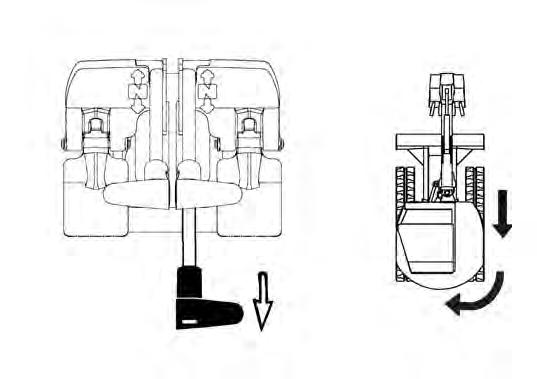
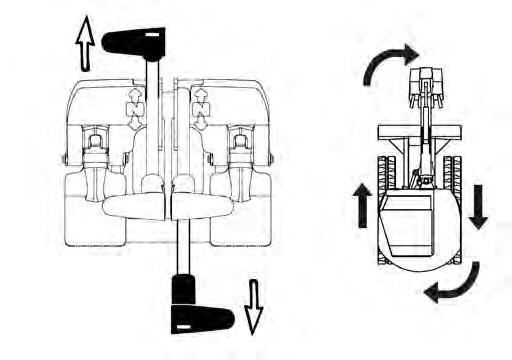
HYDRAULIC CONTROLS Description
The work equipment (boom, arm, bucket, and upperstructure slew) is operated by using the left and right control levers (joysticks).
Left Control Lever (Joystick)
Figure 49
Right Control Lever (Joystick)
The left lever (joystick) is used to operate the arm and slew the upperstructure [Figure 49]

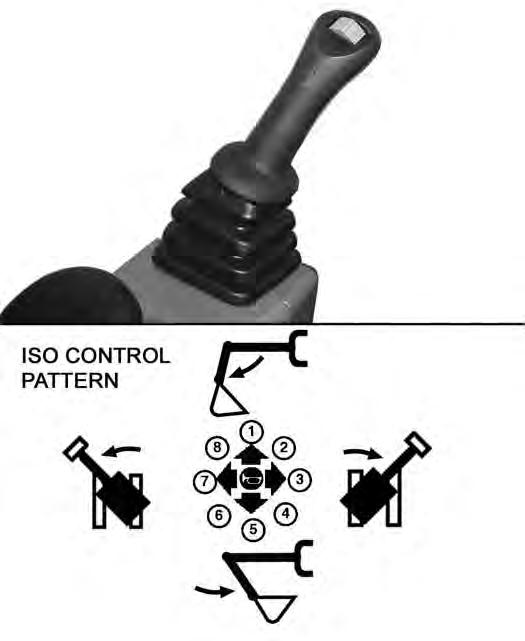
1. Arm out.
2. Arm out and slew right.
3. Slew right.
4. Arm in and slew right.
5. Arm in.
6. Arm in and slew left.
7. Slew left.
8. Arm out and slew left.
Iso Control Pattern
Figure 50 The right lever (joystick) is used to operate the boom and bucket [Figure 50]
1. Boom lower.
2. Boom lower and bucket dump.
3. Bucket dump.
4. Boom raise and bucket dump.
5. Boom raise.
6. Boom raise and bucket curl.
7. Bucket curl.
8. Boom lower and bucket curl.
Warning
AVOID INJURY OR DEATH
Before leaving the machine:
•Lower the work equipment to the ground.
•Lower the blade to the ground.
•Stop the engine and remove the key.
•Raise the control console.
W-2780-0109
HYDRAULIC CONTROLS (CONT’D)
Quick Couplers
Warning
AVOID BURNS
Hydraulic fluid, tubes, fittings and quick couplers can get hot when running machine and attachments. Be careful when connecting and disconnecting quick couplers.
W-2220-0396
Warning
AVOID INJURY OR DEATH
Diesel fuel or hydraulic fluid under pressure can penetrate skin or eyes, causing serious injury or death. Fluid leaks under pressure may not be visible. Use a piece of cardboard or wood to find leaks. Do not use your bare hand. Wear safety goggles. If fluid enters skin or eyes, get immediate medical attention from a doctor familiar with this injury.
W-2072-EN-0909
To Connect:
Remove any dirt or debris from the surface of both the male and female couplers, and from the outside diameter of the male coupler. Visually check the couplers for corroding, cracking, damage, or excessive wear, if any of these conditions exist, the coupler(s) (Item 1) [Figure 51] must be replaced.

Install the male coupler into the female coupler. Full connection is made when the ball release sleeve slides forward on the female coupler.
To Disconnect:
Figure 52
Excavators and attachments are supplied with flush faced couplers (Item 1) [Figure 51].
Hold the male coupler (Item 1). Retract the sleeve (Item 2) [Figure 52] on the female coupler until the couplers disconnect.

HYDRAULIC CONTROLS (CONT’D)
Auxiliary Hydraulics - Standard Instrument Panel
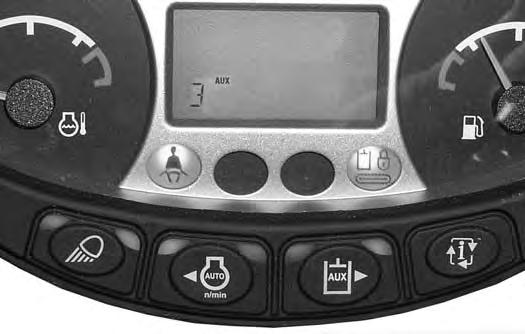
The primary auxiliary hydraulics has Selectable Auxiliary Hydraulic Flow or Continuous Auxiliary Hydraulic Flow. This allows the operator to select a hydraulic flow that matches the attachment hydraulic requirements. The auxiliary hydraulics can be set to Aux3, Aux2, Aux1 or OFF. Aux3 allows maximum hydraulic flow, Aux2 allows medium hydraulic flow and Aux1 allows low hydraulic flow.
Examples For Setting Selectable Auxiliary Hydraulic Flow And The Attachment Used:
Aux Flow Setting Flow Attachments
Aux3MaximumBreaker, Vibratory Plate Compactor, Auger
Aux2MediumClamp, Grapple
Aux1LowPower Tilt, Hydra Tilt
NOTE:Use only approved attachments for your model excavator. Attachments are approved for each model of excavator based on various factors. Using unapproved attachments could cause damage to the attachment or to the excavator.
NOTE:If the auxiliary hydraulics are enabled when the engine is turned OFF, they will stay enabled when the engine is restarted. If Continuous Flow was enabled at engine OFF, it will reset to selectable flow mode.
Selectable Auxiliary Hydraulics Flow - Press the Auxiliary Hydraulics button (Item 1) (an audible beep will sound each time the auxiliary button is pressed). The last selected auxiliary hydraulic flow (Aux3, Aux2 or Aux1) will appear in the data display (Item 2). The LED (Item 3) [Figure 53] will be illuminated.
To change the auxiliary flow, press the Auxiliary Hydraulics button (Item 1) to toggle through the settings, each time the button is pressed, the next setting will appear in the data display (Item 2) [Figure 53]. Once the desired setting is selected, it will stay at that setting until a different auxiliary flow is selected by the operator. (Example: Even if the engine was STOPPED, if Aux2 has been selected, after key OFF and engine restart, the Aux2 setting will still be the active hydraulic flow when the machine is started.)
Continuous Flow Auxiliary Hydraulics - Press and hold the Auxiliary Hydraulics button (Item 1) for more than one second. The LED (Item 4) will illuminate. Press the Auxiliary Hydraulics button (Item 1) [Figure 53] again to scroll through the various continuous flow auxiliary hydraulic settings (3, 2, 1).
Move the switch (Item 1) [Figure 54] on the right control lever to the right to supply hydraulic flow to the female coupler. Move the switch to the left to supply hydraulic flow to the male coupler. If you move the switch halfway, the auxiliary functions move at approximately one-half speed.
Press the button (Item 2) [Figure 54] on the front of the handle to provide continuous flow to the female coupler.
NOTE: Pressing the switch (Item 1) to the left while pressing the button (Item 2) [Figure 54] on the front of the handle will provide continuous flow to the male coupler.

Press the button (Item 2) [Figure 54] a second time to stop auxiliary flow to the quick couplers.
NOTE:Reverse flow can cause damage to some attachments. Use reverse flow with your attachment only if approved. See your attachment Operation & Maintenance Manual for detailed information.
HYDRAULIC CONTROLS (CONT’D)
Auxiliary Hydraulics - Deluxe Instrument Panel

The primary auxiliary hydraulics has Selectable Auxiliary Hydraulic Flow or Continuous Auxiliary Hydraulic Flow. This allows the operator to select a hydraulic flow that matches the attachment hydraulic requirements. The auxiliary hydraulics can be set to Aux3, Aux2, Aux1 or OFF. Aux3 allows maximum hydraulic flow, Aux2 allows medium hydraulic flow and Aux1 allows low hydraulic flow.
Examples For Setting Selectable Auxiliary Hydraulic Flow And The Attachment Used:
Aux Flow Setting
Flow Attachments
Aux3MaximumBreaker, Vibratory Plate Compactor, Auger
Aux2MediumClamp, Grapple
Aux1LowPower Tilt, Hydra Tilt
NOTE:Use only approved attachments for your model excavator. Attachments are approved for each model of excavator based on various factors. Using unapproved attachments could cause damage to the attachment or to the excavator.
NOTE:If the auxiliary hydraulics are enabled when the engine is turned OFF, they will stay enabled when the engine is restarted. If Continuous Flow was enabled at engine OFF, it will reset to selectable flow mode.
Selectable Flow Auxiliary Hydraulics - Press key pad [6] [Figure 55] to scroll through the various front auxiliary hydraulic settings (3, 2, 1).
Continuous Flow Auxiliary Hydraulics - Press and hold the key pad [6] [Figure 55] for more than one second. The continuous flow icons below will illuminate. Press the key pad [6] to scroll through the various continuous flow auxiliary hydraulic settings (3, 2, 1).
ICON DESCRIPTION
Engine OFF - Auxiliary Hydraulics Pressure Relieve

Engine Running - Auxiliary Hydraulics OFF
Auxiliary Hydraulics - Maximum FlowContinuous Flow Disabled
Auxiliary Hydraulics - Medium FlowContinuous Flow Disabled
Auxiliary Hydraulics - Low Flow - Continuous
Flow Disabled
Auxiliary Hydraulics - Maximum FlowContinuous Flow Enabled
Auxiliary Hydraulics - Medium FlowContinuous Flow Enabled
Auxiliary Hydraulics - Low Flow - Continuous Flow Enabled
Move the switch (Item 1) [Figure 56] on the right control lever to the right to supply hydraulic flow to the female coupler. Move the switch to the left to supply hydraulic flow to the male coupler. If you move the switch halfway, the auxiliary functions move at approximately one-half speed.
Press the button (Item 2) [Figure 56] on the front of the handle to provide continuous flow to the female coupler.
NOTE: Pressing the switch (Item 1) to the left while pressing the button (Item 2) [Figure 56] on the front of the handle will provide continuous flow to the male coupler.
Press the button (Item 2) [Figure 56] a second time to stop auxiliary flow to the quick couplers.
NOTE:Reverse flow can cause damage to some attachments. Use reverse flow with your attachment only if approved. See your attachment Operation & Maintenance Manual for detailed information.
HYDRAULIC CONTROLS (CONT’D)
Relieve Hydraulic Pressure With Standard Instrument Panel (Excavator And Attachment)

Excavator:
Put the attachment flat on the ground.
Stop the engine and turn the key switch to ON.
NOTE: The left console must be fully lowered for relieving hydraulic pressure.
NOTE:Excavator engine must have recently been started to relieve hydraulic pressure.
Relieve Hydraulic Pressure With Deluxe Instrument Panel (Excavator And Attachment)
Excavator:
Put the attachment flat on the ground.
NOTE:Excavator engine must have recently been started to relieve hydraulic pressure.
If the auxiliary hydraulics are disabled, press AUX HYD Button (Item 1) [Figure 57] and then move the switch (Item 1) [Figure 56] to the right and left several times.
If the auxiliary hydraulics are enabled, then move the switch (Item 1) [Figure 56] to the right and left several times.
Attachments:
• Follow procedure above to relieve hydraulic pressure in excavator.
•Connect male coupler from attachment to female coupler of excavator then repeat procedure above. This will relieve pressure in the attachment.
•Connect the female coupler from the attachment.
Hydraulic pressure in the auxiliary hydraulic system can make it difficult to engage quick couplers to an attachment.
Stop the engine and turn the start switch to ON. Press either scroll button (Item 1) [Figure 58] (Deluxe Panel) until the above screen is visible.

Press Button [6] [Figure 58] and the [AUX PRESSURE RELEASE] screen [Figure 59] will be visible.
Press the [ENTER] button (Item 1) [Figure 59] to relieve auxiliary pressure in the excavator. An hour glass symbol will appear and when pressure is relieve, the screen will show [AUXILIARY HYDRAULIC PRESSURE RELEASE].

Attachments:
• Follow procedure above to relieve hydraulic pressure in excavator.
•Connect male coupler from attachment to female coupler of excavator then repeat procedure above. This will relieve pressure in the attachment.
•Connect the female coupler from the attachment.
Hydraulic pressure in the auxiliar y hydraulic system can make it difficult to engage quick couplers to an attachment.
HYDRAULIC CONTROLS (CONT’D)
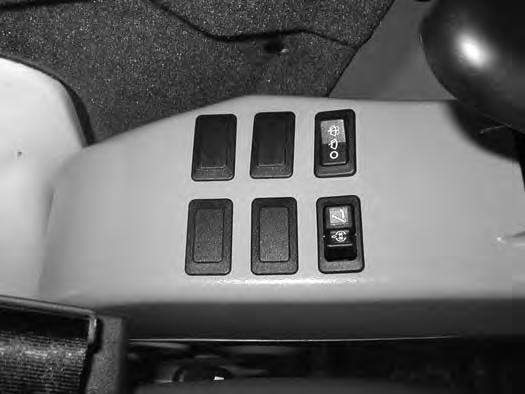
Secondary Auxiliary Hydraulics
When equipped with secondar y auxiliary hydraulics, the second set of hydraulic couplers will be mounted on the right side of the arm.
Relieve Secondary Auxiliary Hydraulic Pressure (Excavator And Attachment)
Excavator:
Put the attachment flat on the ground.
Stop the engine and turn the key to ON.
NOTE: The left console must be fully lowered for relieving hydraulic pressure.
NOTE:Excavator engine must have recently been started to relieve hydraulic pressure.
Press
Attachments:
• Follow procedure above to relieve pressure in excavator.
•Connect male coupler from attachment to female coupler of excavator then repeat procedure above. This will relieve pressure in the attachment.
•Connect the female coupler from the attachment.
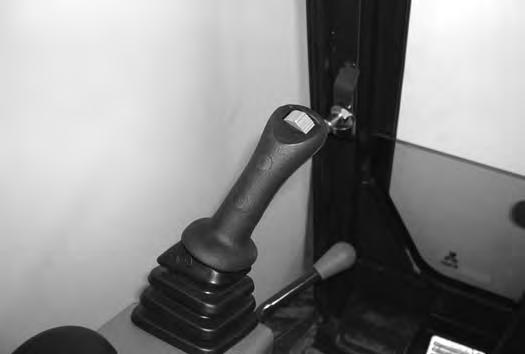
Hydraulic pressure in the auxiliary hydraulic system can make it difficult to engage quick couplers to an attachment.
Move the switch (Item 1) [Figure 61] on the left control lever to the left to supply hydraulic flow to the female coupler Move the switch to the right to supply hydraulic flow to the male coupler. If you move the switch halfway, the auxiliary functions move at approximately one-half speed.
HYDRAULIC CONTROLS (CONT’D)
Return To Tank Valve
The return to tank valve is located under the right side cover at the front of the control valve (if equipped).
Overload Warning Device
Description
The overload warning device, when engaged, will alert the operator with a warning buzzer and the general warning icon on the instrument panel when the work group is overloaded.


If overload occurs, immediately bring the arm toward the machine, lower the boom and reduce the load before continuing operation.
Operation
Rotate the lever (Item 1) [Figure 62] clockwise to direct auxiliary return hydraulic fluid to the reservoir.

Rotate the lever (Item 1) [Figure 62] anticlockwise for two way hydraulic auxiliary flow operation.
Press the switch (Item 1) [Figure 63] to the right to enable the Overload Warning Device.
A buzzer will sound and the general warning icon (Item 1) [Figure 64] will illuminate when the boom is overloaded.
To disengage the overload warning device, press the switch (Item 1) [Figure 63] to the left. The icon (Item 1) [Figure 64] will turn off when the overload warning device is disabled.
NOTE:The Overload Warning Device must be turned on for objected handling applications.
Blade Control Lever


Raising And Lowering Blade
Figure 65
Pull the lever backward to raise the blade (Item 1) [Figure 65]
Push the lever forward to lower the blade (Item 2) [Figure 65]
Push the lever (Item 3) [Figure 65] forward until the lever is in the locked position to put the blade in the float position.
Pull the lever backward to unlock from the float position.
NOTE: Keep blade lowered for increased digging performance.
Engine Speed Control Dial
Setting Engine Speed (RPM)
Figure 66
The engine speed control dial (Item 1) [Figure 66] controls engine rpm.
Rotate the engine speed control dial anticlockwise (Item 2) to reduce engine rpm. Rotate the engine speed control dial clockwise (Item 3) [Figure 66] to increase engine rpm.
ECO Mode (With Deluxe Instrument Panel Only)
If equipped with the Deluxe Instrument Panel, ECO mode is available.
To enable ECO mode: (See ECO MODE on Page 200.)
The switch (Item 1) [Figure 67] on the left control lever (joystick) controls boom swing. Move the switch to the left to swing the boom to the left. Move the switch to the right to swing the boom to the right.

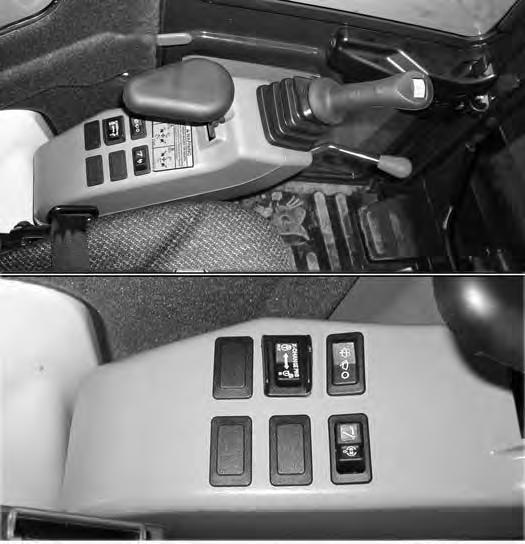
If Equipped With Secondary Auxiliary Hydraulics:
If the machine is equipped with secondar y auxiliar y hydraulic couplers, the switch (Item 2) [Figure 67] is used to select either the boom swing function or the secondar y auxiliary hydraulic function.
Move the switch (Item 2) [Figure 67] to the left to select boom swing function, move the switch to the right to select secondary auxiliary hydraulic function.
NOTE: The purpose of the boom swing is to offset the boom with respect to the upperstructure for digging close to a structure [Figure 68].
BOOM LOAD HOLDING VALVE
Description
The boom load holding valve (if equipped) will hold the boom in it’s current position in the event of hydraulic pressure loss.
NOTE:Load Holding valves may be required for lifting objects. Check the regulations in your area. See your Bobcat dealer for load holding valves for your model excavator.
Warning
AVOID INJURY OR DEATH
Do Not work or stand under raised work equipment or attachment.
W-2793-0409
Lowering Boom With Load Holding Valve
NOTE:The boom load holding valve is required for object handling applications.

Warning
AVOID BURNS
Hydraulic fluid, tubes, fittings and quick couplers can get hot when running machine and attachments. Be careful when connecting and disconnecting quick couplers.
If the excavator is equipped with a boom load holding valve (Item 1) [Figure 69], it will be attached to the boom cylinder at the base end.
NOTE:DO NOT remove or adjust the two port relief valves (Item 2) [Figure 69]. If the port relief valves have been tampered with, see your Bobcat dealer for service.

BOOM LOAD HOLDING VALVE (CONT’D)
Lowering Boom With Load Holding Valve (Cont’d)
Figure 71
Loss of hydraulic pressure:
Use the same procedure as: With rod end hose failure and NO accumulator pressure.
Lowering procedures:
With base end hose failure:
Loosen the jam nut (Item 1). Install a hex wrench into the valve screw (Item 2) [Figure 71] and slowly rotate the screw clockwise 1/8 to 1/4 turn and allow the boom to lower to the ground.
After the boom is fully lowered, rotate the screw anticlockwise (Item 2) 1/8 to 1/4 turn and tighten the lock nut (Item 1) [Figure 71]
With rod end hose failure - with accumulator pressure:
Place a container under the valve and hose end to contain hydraulic fluid. Enter the excavator and turn the key to the ON position or press the [ENTER CODE] Button (Keyless Panel), but do not start the engine. Slowly move the joystick boom lower function and allow the boom to lower to the ground.
With rod end hose failure and NO accumulator pressure:
Remove the boom base end hose from the boom load holding valve. Place a container under the valve and base end hose to contain hydraulic fluid.
Loosen the jam nut (Item 1). Install a hex wrench into the valve screw (Item 2) [Figure 71] and slowly rotate the screw clockwise 1/8 to 1/4 turn and allow the boom to lower to the ground.
After the boom is fully lowered, rotate the screw (Item 2) anticlockwise 1/8 to 1/4 turn and tighten the lock nut (Item 1) [Figure 71]. Reinstall the base end hose.

ARM LOAD HOLDING VALVE
Description
The arm load holding valve (if equipped) will hold the ar m in it’s current position in the event of hydraulic pressure loss.
NOTE:Load Holding valves may be required for lifting objects. Check the regulations in your area. See your Bobcat dealer for load holding valves for your model excavator.
Warning
AVOID INJURY OR DEATH
Do Not work or stand under raised work equipment or attachment.
W-2793-0409
Lowering Arm With Load Holding Valve
Figure 72
NOTE: DO NOT remove or adjust the two port relief valves (Item 1) [Figure 73]. If the port relief valves have been tampered with, see your Bobcat dealer for service.

If the excavator is equipped with arm load holding valve (Item 1) [Figure 72], it will be attached to the arm cylinder base end as shown.
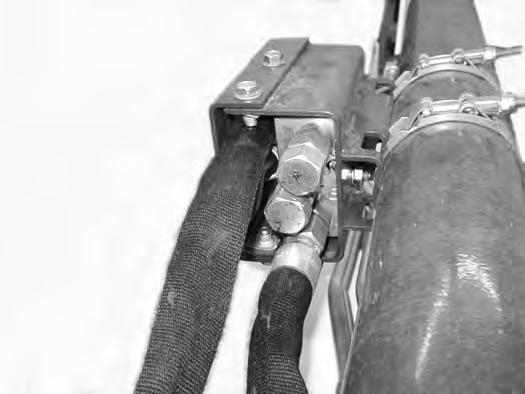
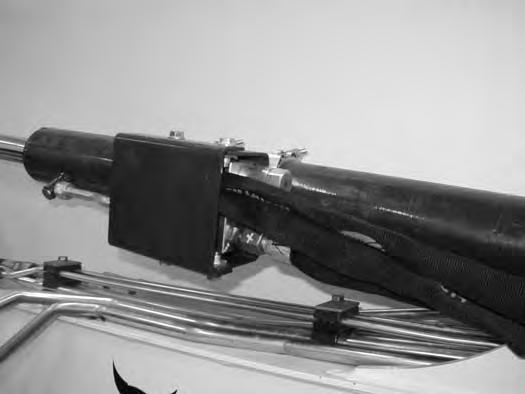
Warning
AVOID BURNS
Hydraulic fluid, tubes, fittings and quick couplers can get hot when running machine and attachments. Be careful when connecting and disconnecting quick couplers.
W-2220-0396
ARM LOAD HOLDING VALVE (CONT’D)
Lowering Arm With Load Holding Valve (Cont’d)
Figure 75
Loss of hydraulic pressure:

Use the same procedure as: With rod end hose failurewith NO accumulator pressure above.
Lowering procedures:
With base end hose failure:
Loosen the jam nut (Item 1). Install a hex wrench into the valve screw (Item 2) [Figure 75] and slowly rotate the screw clockwise 1/8 to 1/4 turn and allow the arm to lower.
After the arm is lowered, rotate the screw anticlockwise (Item 2) the same 1/8 to 1/4 turn and tighten the lock nut (Item 1) [Figure 75]
With rod end hose failure - with accumulator pressure:
Place a container under the valve and hose end to contain hydraulic fluid. Enter the excavator and turn the key to the ON position or press the [ENTER CODE] button (Keyless Panel), but do not start the engine. Move the joystick arm retract function to slowly lower the arm.
With rod end hose failure and NO accumulator pressure:
Remove the arm base end hose from the arm load holding valve. Place a container under the valve and base end hose to contain hydraulic fluid.
Loosen the jam nut (Item 1). Install a hex wrench into the valve screw (Item 2) [Figure 75] and slowly rotate the screw clockwise 1/8 to 1/4 turn and allow the arm to lower.
After the arm is lowered, rotate the screw (Item 2) anticlockwise 1/8 to 1/4 turn and tighten the lock nut (Item 1) [Figure 75]. Reinstall the base end hose.
Daily Inspection
Daily Inspection And Maintenance
Figure 76
Warning
Operator must have instructions before operating the machine. Untrained operators can cause injury or death.
W-2001-0502
Fluids such as engine oil, hydraulic fluid, coolants, etc. must be disposed of in an environmentally safe manner. Some regulations require that certain spills and leaks on the ground must be cleaned in a specific manner. See local, state, and federal regulations for correct disposal.
Maintenance work must be done at regular intervals. Failure to do so will result in excessive wear and early failures. The Service Schedule is a guide for correct maintenance of the Bobcat excavator. The decal (Item 1) [Figure 76] is located inside the rear door. (See SERVICE SCHEDULE on Page 145.)
Check the following items before each day of operation:
•Operator Canopy or Cab (ROPS / TOPS) and mounting hardware.
•Seat belt and mounting hardware. Replace seat belt if damaged.
•Check for damaged decals, replace as needed.
•Check control console lockout.
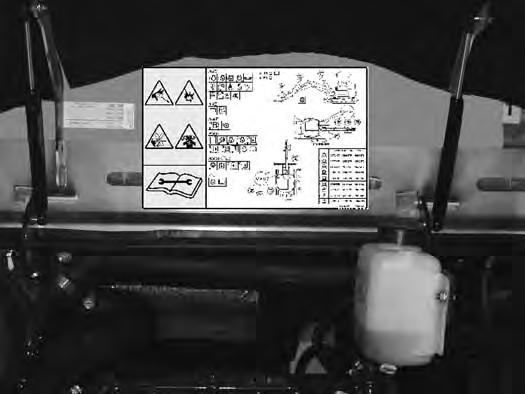
•Check X-Change System (if equipped) for damage or loose parts.
•Air cleaner and intake hoses / clamps.
•Engine oil level and engine for leaks.
•Engine coolant level and engine for leaks.
•Check engine area for flammable materials.
•Check hydraulic fluid level and system for leaks.
•Check indicator lights for correct operation.
•Grease all pivot points.
•Check cylinder and attachment pivot points.
•Check the track tension.
•Repair broken and loose parts.
•Check or clean cab heater filters (if equipped).
•Check front horn and motion alarm (if equipped) for proper function.
Important
Pressure Washing Decals
•Never direct the stream at a low angle toward the decal that could damage the decal causing it to peel from the surface.
•Direct the stream at a 90 degree angle and at least 300 mm (12 in) from the decal. Wash from the centre of the decal toward the edges.
I-2226-EN-0910
Important
This machine is factory equipped with a spark arrester exhaust system.
The spark arrester muffler, if equipped, must be cleaned to keep it in working condition. The spark arrester muffler must be serviced by dumping the spark chamber every 100 hours of operation.
On some models, the turbocharger functions as the spark arrester and must operate correctly for proper spark arrester function.
If this machine is operated on flammable forest, brush, or grass covered land, a spark arrester attached to the exhaust system may be required and must be maintained in working order. Refer to local laws and regulations for spark arrester requirements.
I-2284-EN-0909
PRE-STARTING PROCEDURE
Operation & Maintenance Manual And Operator’s Handbook Locations
Entering The Excavator

Warning
AVOID INJURY OR DEATH
Instructions are necessary before operating or servicing machine. Read and understand the Operation & Maintenance Manual, Operator’s Handbook and signs (decals) on machine. Follow warnings and instructions in the manuals when making repairs, adjustments or servicing. Check for correct function after adjustments, repairs or service. Untrained operators and failure to follow instructions can cause injury or death.
W-2003-0807
Read and understand the Operation & Maintenance Manual (Item 1) [Figure 77] (located inside the storage box on the back of the operator’s seat) and the Operator’s Handbook (Item 1) [Figure 78] before operating.












